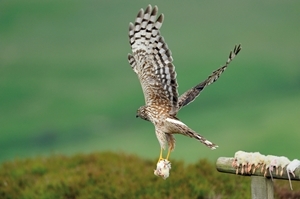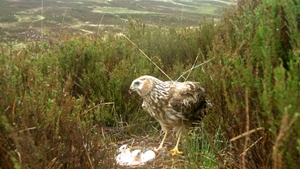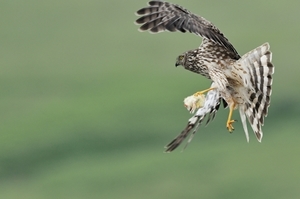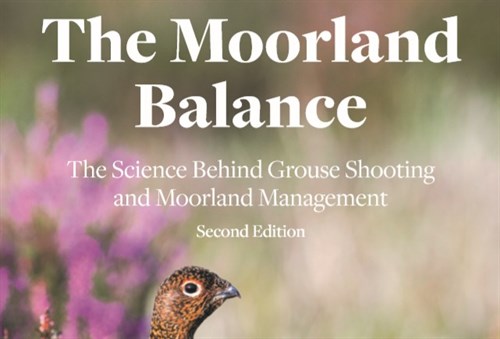Key points
- Almost half of hen harrier diet in this study was made up of diversionary food. Red grouse chicks made up only 0-4% of hen harrier diet.
- This means 0-6% of grouse chicks produced per year were fed to hen harrier chicks.
- The number of grouse chicks fed to hen harrier chicks each year was 34-100% lower than predicted in unfed conditions.
- However, feeding of hen harriers alongside grouse moor management did not increase grouse numbers enough to sustain economically viable driven shooting.
Background
 There has been long-standing conflict between red grouse shooting and the conservation of raptors, particularly hen harriers. Hen harriers are often perceived as a risk to shooting interests because they can keep grouse at low numbers and reduce shooting bags to the extent that driven shooting is no longer economically viable. As a result, hen harriers are killed illegally, which we know limits both their numbers and distribution in Britain.
There has been long-standing conflict between red grouse shooting and the conservation of raptors, particularly hen harriers. Hen harriers are often perceived as a risk to shooting interests because they can keep grouse at low numbers and reduce shooting bags to the extent that driven shooting is no longer economically viable. As a result, hen harriers are killed illegally, which we know limits both their numbers and distribution in Britain.
Diversionary feeding of hen harrier broods means offering alternative food that adult hen harriers can take for their chicks. It has been suggested as a method to reduce the impact of hen harrier predation on grouse. If successful, this could reduce the motivation for illegal killing. In a past experimental study, diversionary feeding reduced the number of grouse chicks fed to hen harrier broods by 64-94%. However, only half of the hen harrier broods were fed, and there was no positive effect on autumn grouse density.
Diversionary food was made available to all hen harrier broods on Langholm Moor between 2008 and 2015 as part of the Langholm Moor Demonstration Project. It was introduced along with restarting grouse moor management, a package including predator and disease control as well as heather management. The aim was to test whether sustainable driven grouse shooting could be restored in the presence of breeding hen harriers.
In this study, scientists studied the use of diversionary food by hen harriers, and how much diversionary food and natural prey (including red grouse chicks) was delivered to hen harrier broods on Langholm Moor.
What they did
 Between 2008 and 2015, all 25 hen harrier broods were provided with diversionary food (day-old poultry chicks and rats). Fresh food was provided daily on feeding posts near hen harrier nests for up to 60 days after the chicks hatched.
Between 2008 and 2015, all 25 hen harrier broods were provided with diversionary food (day-old poultry chicks and rats). Fresh food was provided daily on feeding posts near hen harrier nests for up to 60 days after the chicks hatched.
The diet of 15 hen harrier broods was observed using three different methods: observation from hides, video footage from nest cameras, and analysis of prey remains in regurgitated pellets (indigestible prey parts such as feathers, fur or bones). The white colour of poultry chicks and rats made diversionary food easy to identify.
Prey was classified as diversionary (poultry chicks or rats) or natural (songbirds, small mammals, red grouse chicks or other prey). When prey could not be identified, it was classified as unknown. The proportion of each prey type was calculated for each brood. The scientists then estimated the total number of grouse chicks fed to hen harrier broods in each year. Using information from previous studies on hen harrier diet, they also predicted how many grouse chicks would have been expected to be fed to hen harrier broods if there was no diversionary food available.
What they found
The uptake of diversionary feeding by harriers was good; it took on average four days between first providing the food and it being accepted by the hen harriers. In total, 76% of the food provided was taken from the feeding posts. There was some infrequent scavenging by other species such as ravens, but this was mainly after hen harrier chicks had fledged.
Depending on the assessment method used, the scientists found that hen harrier nestling diet contained on average 44-53% diversionary food, 39-55% natural prey (including 24-45% songbirds, 4-15% small mammals, 0-4% red grouse chicks) and 0-9% unknown items. The amount of diversionary food that nestlings received did not change when the abundance of natural prey changed.
The number of grouse chicks fed to hen harrier broods in each year represented 0-6% of grouse chicks produced per year. This was 34-100% lower than would be expected without diversionary feeding.
What does this mean?
 This study showed that providing diversionary food influenced hen harrier nestling diet and reduced the number of grouse chicks fed to harrier broods, compared to what was expected. However, the combination of diversionary feeding and grouse moor management did not increase the grouse density enough to support driven grouse shooting. At Langholm Moor, the recovery of grouse may have been limited by other factors, including other predators, bad weather (especially for chicks), or insufficient habitat recovery.
This study showed that providing diversionary food influenced hen harrier nestling diet and reduced the number of grouse chicks fed to harrier broods, compared to what was expected. However, the combination of diversionary feeding and grouse moor management did not increase the grouse density enough to support driven grouse shooting. At Langholm Moor, the recovery of grouse may have been limited by other factors, including other predators, bad weather (especially for chicks), or insufficient habitat recovery.
Diversionary feeding of harriers may still help to restore or maintain driven shooting on other moors. However, estate owners may be reluctant to adopt this technique without better evidence that it can contribute to successful driven shooting.
Read the original abstract
Ludwig, S.C., McCluskie, A., Keane, P., Barlow, C., Francksen, R.M., Bubb, D., Roos, S., Aebischer, N.J., & Baines, D. (2018). Diversionary feeding and nestling diet of Hen Harriers Circus cyaneus. Bird Study, 65: 431-443.
About the LMDP
This study was part of the Langholm Moor Demonstration Project, a long-running collaboration between the GWCT, SNH, Buccleuch Estates, the RSPB and Natural England, which aimed to resolve the conflict between driven grouse shooting and raptor conservation. Further papers from the Langholm Moor Demonstration Project can be found on the LMDP website.
Photo credit: Laurie Campbell

The Moorland Balance - eBook - only £4.99
Get the science behind grouse shooting and moorland management. Building on the success of the first edition, this new and improved version condenses thousands of pages of scientific literature into easy-to-read questions and answers. Over 200 different studies from across the scientific community are referenced in this 134-page book.
View Book >
or
Buy Now - £4.99 >
100% Secure. All Credit & Debit cards, PayPal, Apple Pay and Google Pay accepted.
